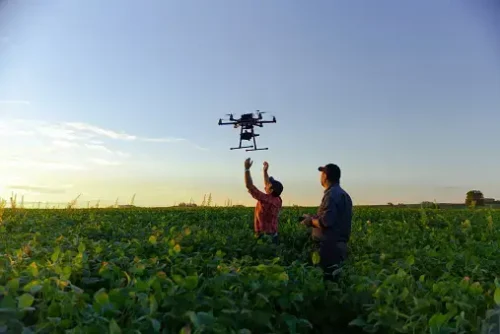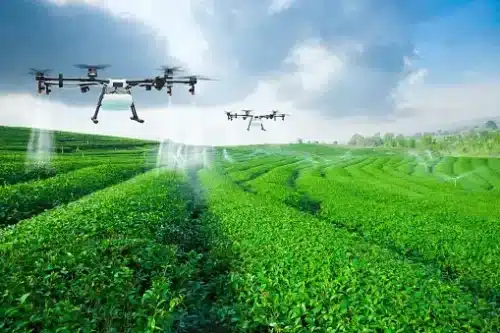
Top 5 Ways Drones Are Revolutionizing Modern Farming
Drone technology has revolutionized operations in various sectors like modern farming. It has been used in wars for surveillance and unmanned combat vessels, videography to facilitate areal capture of images and videos, and in many areas.
While most people expect drones to be found only in tech and photography-related sectors, drones have proved versatile and available for almost every sector.
Contrary to the expectation of many people, drones—also known as unmanned aerial vehicles (UAVs)—have proved very useful in the Agricultural sector.
Framing is very important to man’s existence. It is the main source of food in the universe. Being affected by continuously increasing problems, including pests and diseases, weeds, drought, and many more, the agricultural sector has appreciated using technology to wade through these many challenges.
One of the ways of enhancing the interventions geared toward solving challenges facing farming is the use of drones.
Here are the top ways in which drones are revolutionizing modern farming:
1. Help in Crop and Animal Surveillance
One of the top benefits of using UAVs in farming is surveillance. Every tech-savvy farmer should equip themselves with drones used in farming and use them to deal with surveillance issues. This is important for both crop farming and animal husbandry.
Well-done crop surveillance comprises keeping track of crop progress from planting until they are ready for harvesting.
Surveillance is crucial in agriculture and should be rated as non-negotiable by any farmer keen on maximizing their produce. It keeps farmers informed of the health of their crops, helping them identify those affected by crop diseases and those choked by weeds.
In the case of farmers practicing animal husbandry, there is a need to know how their animals are doing, especially if the herd is a big one. Identifying and separating sick animals from the rest of the herd is significant before they can transfer diseases and endanger the entire herd.
Traditional, non-UAVs applying methods depend on manual human surveillance. Farmers have the painful duty of manually walking around their farms, section by section, to monitor their crops’ growth and identify areas that need specific attention. It is the same with animals; walking around them and trying to see if attention is needed.
In the case of animals, this may not be a good idea. Some animals can be hostile if you get too close to them. All in all, manual surveillance, both for crop farming and animal husbandry, is tedious and time intensive.
Employing drone technology can make this work easier and more cost-effective. You only need one drone comptroller to accomplish great work that typically involves many people, depending on the farm size.
The drones used for crop surveillance have a special in-built imaging system known as the Normalized Difference Vegetation Index. It monitors the crop absorbance of distinct wavelengths, forming a pigment contrast with comprehensive pigment information that visibly reflects plant health and potential troublesome locations.
Read More: How Can Modern Technology Get the Best from Your Workforce?
2. Helps With Seed Planting
Seed planting is one stage of farming that must be done well. You need good spacing to ensure the crops grow well and yield well. Drones can help with focused and perfect planting maintaining a perfect spacing pattern across the farm. Drones also assist in applying necessary planting inputs, such as fertilizers, with such precision that it results in uniform crop yield.
To use a drone for seed planting, you start by loading coated seeds into the canister appended to the drone. The pilot then directs the drone to the seeding field and releases them using the controllers.
Drone planting can prove beneficial and efficient when reforestation efforts in severely endangered protected forests.
3. Guided Irrigation
Drone technology can also help with irrigation. While a crop’s water requirement is consistent within the specie, the farm situation can affect the crops differently. Some places can be well water, while others may be lacking. Knowing which areas to irrigate can be hard, especially in large-hectare farms.
UAVs with hyperspectral, multispectral, or thermal sensors can help a farmer conduct guided irrigation. They can distinguish which field sections are dry or require water adjustments. This helps a framer to arrange for water adjustment through area-specific irrigation.
4. Enhances Farm Security
Farm security is very important. Unauthorized individuals should have access to your farm. You will need to walk around to see if some people or animals should stay away from your farm. You can walk around to keep destructors like birds, animals, and ill-motivated people from accessing your farm.
Unfortunately, ultramodernist farming demands large tracts of land that can be hard and expensive to keep secure manually.
Drone technology is a safe application to help boost farm security. It extensively detects every detail that can pose a security threat and reports it for urgent attention. The drones can be deployed to maintain a 24/7b watch, remaining on duty day and night.
Furthermore, with its stabilized 360-degree view of the farm, drones can help you detect approaching security concerns–animals, people, birds, et cetera.—and respond in real-time.
5. Revamps Spray Treatment
Pests and diseases affecting crops in the field need robust intervention. Such an intervention should reach deep and remain comprehensive enough to reach every pathogen and pest present.
Spraying remains the most effective way to deal with pests. Traditional manual spraying has been very helpful to help in controlling pests. This is especially in small-scale subsistence farming. Some farmers can also apply it on a large scale and go through the pain of trailing large tracts of farmland trying to reach out to every destructive micro-organism.
Unfortunately, manual spraying is not the best method at this time. With global nutritional needs skyrocketing as the population knocks 8 billion, the need to increase the scale of production to feed the world is becoming dearer. Most farmers practice large-scale farming, making interventions to care for crops and control pests and weed infestation a little cumbersome.
Modern-day farming employs the use of drone-mounted sprayers to overcome the drawbacks of manual spraying. With extensive abilities—capable of carrying up to 40-liter pesticide tank and following a pre-mapped route-—drone spraying device meets the crop’s spraying requirements.
If you are farming in fields with difficult access to machinery like tractors or aircraft, drones, with their ability to fit into every crevice, will be very useful. Drone technology has greatly revamped spray treatment, enhancing chemical effectiveness and coverage capacity in the process.
Read More: Digital Revolution: How Technology Is Changing the Nature of Money
Bottomline
Drone technology has made a substantial difference in modern-day farming. Most tasks that were traditionally carried out in a manual and labor-intensive way are revolutionized and simplified using UAVs.
Drones can help with farm surveillance to detect crop diseases and even sick animals if a farm involves animal husbandry. It also helps with administering various interventions like spraying treatment.
Every farmer, especially those practicing large-scale farming, should appreciate drone technology in their farming.





